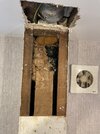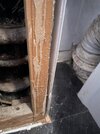Internal soil stack of 1950’s built house. Comes up through a collar on kitchen floor and is boxed in to ceiling. There is an elbow coming off the soil stack that sweeps up into a collar in the first floor toilet. A flexible toilet pipe then joins this to the toilet. The soil stack itself continues up towards the attic. Parts of the stack seem to be cast iron, other parts are something else.
Water marks on the kitchen ceiling led me to investigate. There is weeping around the joint of the elbow from the stack to the toilet, it can be seen that this has had an attempted ‘fix’ previously.
Is it possible to remove this elbow and replace with a shiny new plastic one? If so, what would be the best way to go about this, as in how much of the elbow would need to remain in place to connect a plunge fit connector in order to add the new plastic elbow?
The toilet is getting replaced so now would be the time to make the plumbing right.
I’ll add pictures to make clearer what I’m trying to ask advice about.
I very much appreciate any help offered!!







Water marks on the kitchen ceiling led me to investigate. There is weeping around the joint of the elbow from the stack to the toilet, it can be seen that this has had an attempted ‘fix’ previously.
Is it possible to remove this elbow and replace with a shiny new plastic one? If so, what would be the best way to go about this, as in how much of the elbow would need to remain in place to connect a plunge fit connector in order to add the new plastic elbow?
The toilet is getting replaced so now would be the time to make the plumbing right.
I’ll add pictures to make clearer what I’m trying to ask advice about.
I very much appreciate any help offered!!







